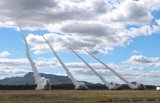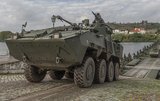Australia looks towards space with force restructure, investment and training
Australia is looking to improve its presence in space with a focus on communications and creating a dedicated segment of its defence forces committed to the domain.
A Mobile User Objective System (MUOS) satellite communications (SATCOM) demonstration has been conducted to connect an in-flight US Air Force (USAF) C-17 aircraft with a simulated airlift operations centre at Scott Air Force Base.
The aircraft and operations centre used MUOS-equipped AN/PRC-155 radios to exchange voice, data and flight status monitoring information using the MUOS satellite communications system as the C-17 flew over the Pacific Ocean.
The four-day demonstration, supported by General Dynamics C4 Systems, saw the MUOS-Manpack PRC-155 two-channel radios aboard the aircraft consistently send and receive secure voice and data communications, including in-flight position and location information, with the operations centre at Scott Air Force Base. The MUOS Manpack PRC-155 radio also used a loosely coupled airborne networking suite to route flight-path changes from the command centre directly to the pilot and aircrew, displaying the information on portable cockpit mission displays.
Data from the aircraft's flight computers travelled securely from the PRC-155 radio, over the MUOS satellite and down to the PRC-155 radio in the operations centre allowing Air Force personnel to watch the aircraft's flight on their mission tracking/status workstation displays.
Chris Marzilli, president, General Dynamics C4 Systems, said: ‘The air force reached out to General Dynamics asking us to demonstrate how the PRC-155 Manpack radio and the MUOS SATCOM system would work in an airborne C-17. The air force observers experienced the cellphone-like voice clarity during conversations with the flight crew and realised the powerful new voice and data capability this communications combination represents.’
The MUOS satellite communications system offers more than 10-times the data capacity of the legacy UHF satellite communications system that is more than 20-years old. To connect to the MUOS satellite system, radios, like the PRC-155, must have the MUOS communications waveform that is based on commercial cellular networks technologies.

Australia is looking to improve its presence in space with a focus on communications and creating a dedicated segment of its defence forces committed to the domain.

The Portuguese company’s naval communications system is in service across more than a dozen countries. It has turned to its home nation for support in developing a new vehicle based C2 system.

The Vision4ce Deep Embedded Feature Tracking (DEFT) technology software is designed to process video and images by blending traditional computer vision with artificial intelligence (AI) algorithms to present actionable information from complex environments.

Persistent Systems has been cleared by National Security Agency (NSA) to transmit sensitive data on commercial networks. The devices are added to the NSA’s Commercial Solutions for Classified (CSfC) component list which also includes other companies’ products providing the same security.

The release of the UK’s Strategic Defence Review (SDR) has been long promised as mid-year. It is possible it could be as early as 2 June although the UK Ministry of Defence (MoD) continues to play its cards close to its chest.

Intelsat outlines how its multi-orbit SATCOM architecture is enhancing connectivity and resilience for special operations forces operating in degraded and contested environments.